manual transmission HONDA FIT 2017 3.G Quick Guide
[x] Cancel search | Manufacturer: HONDA, Model Year: 2017, Model line: FIT, Model: HONDA FIT 2017 3.GPages: 76, PDF Size: 8.56 MB
Page 47 of 76
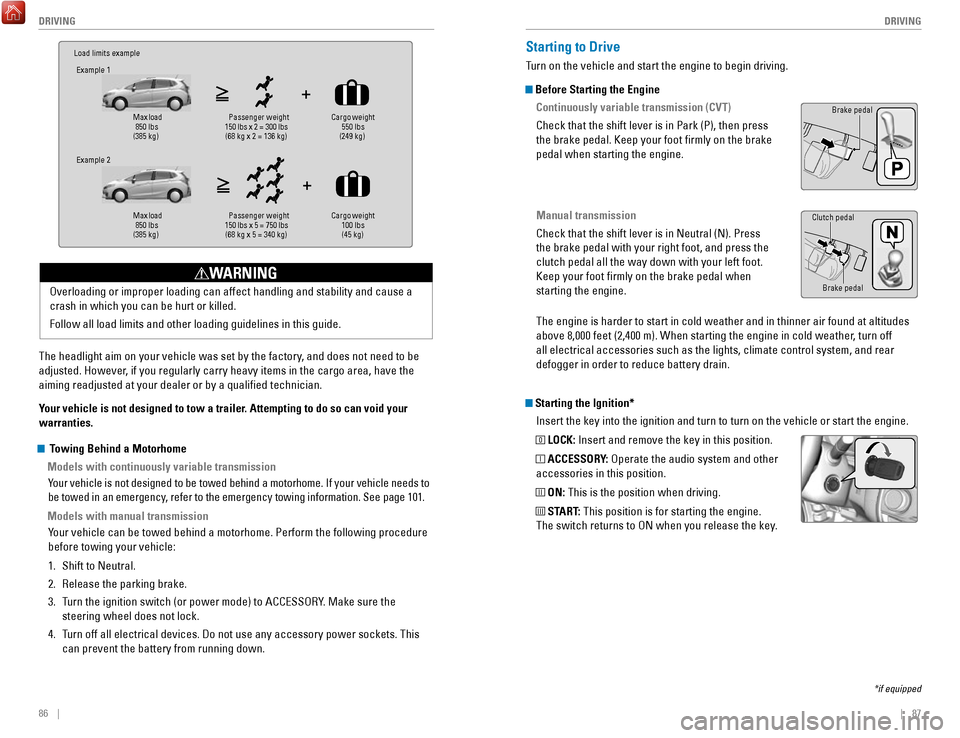
86 || 87
DRIVING
DRIVING
Load limits example
Example 1
Max load
850 lbs
(385 kg) Pass
enger weight
150 lbs x 2 = 300 lbs (68 kg x 2 = 136 kg) Cargo weight
550 lbs
(249 kg)
Example 2
Max load
850 lbs
(385 kg) Pa
ssenger w eight
150 lbs x 5 = 750 lbs (68 kg x 5 = 340 kg) Cargo weight
100 lbs
(45 kg)
The headlight aim on your vehicle was set by the factory, and does not need to be
adjusted. However, if you regularly carry heavy items in the cargo area, have the
aiming readjusted at your dealer or by a qualified technician.
Your vehicle is not designed to tow a trailer. Attempting to do so can void your
warranties. Overloading or improper loading can affect handling and stability and ca\
use a
crash in which you can be hurt or killed.
Follow all load limits and other loading guidelines in this guide.
WARNING
Starting the Ignition*
Insert the key into the ignition and turn to turn on the vehicle or star\
t the engine.
0 LOCK: Insert and remove the key in this position.
I ACCESSORY: Operate the audio system and other
accessories in this position.
II ON: This is the position when driving.
III START: This position is for starting the engine.
The switch returns to ON when you release the key.
Starting to Drive
Turn on the vehicle and start the engine to begin driving.
Before Starting the Engine
Continuously variable transmission (CVT)
Check that the shift lever is in Park (P), then press
the brake pedal. Keep your foot firmly on the brake
pedal when starting the engine.
Manual transmission
Check that the shift lever is in Neutral (N). Press
the brake pedal with your right foot, and press the
clutch pedal all the way down with your left foot.
Keep your foot firmly on the brake pedal when
starting the engine.
Brake pedal
The engine is harder to start in cold weather and in thinner air found a\
t altitudes
above 8,000 feet (2,400 m). When starting the engine in cold weather, turn off
all electrical accessories such as the lights, climate control system, a\
nd rear
defogger in order to reduce battery drain.
*if equipped
Brake pedal
Clutch pedal
Towing Behind a Motorhome
Models with continuously variable transmission
Your vehicle is not designed to be towed behind a motorhome. If your vehi\
cle needs to
be towed in an emergency, refer to the emergency towing information. See page 101.
Models with manual transmissionYour vehicle can be towed behind a motorhome. Perform the following proce\
dure
before towing your vehicle:
1.
Shift to Neutral.
2.
Release the parking brake.
3.
Turn the ignition switch (or power mode) to ACCESSORY. Make sure the
steering wheel does not lock.
4.
Turn off all electrical devices. Do not use any accessory power sockets. This
can prevent the battery from running down.
Page 48 of 76
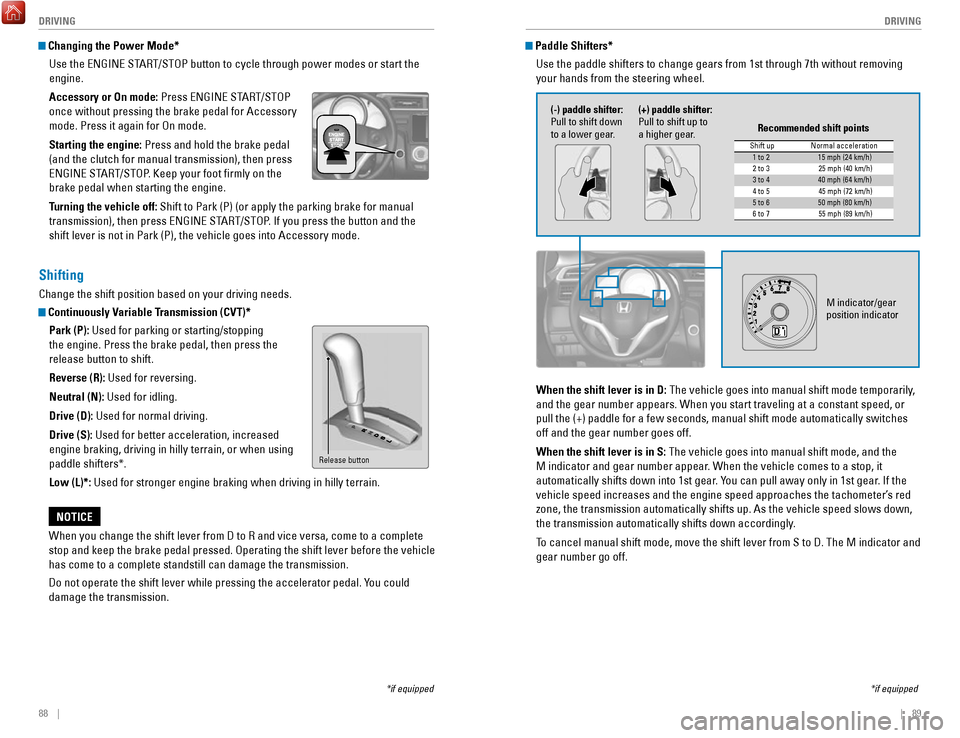
88 || 89
DRIVING
DRIVING
Changing the Power Mode*
Use the ENGINE START/STOP button to cycle through power modes or start the
engine.
Accessory or On mode: Press ENGINE START/STOP
once without pressing the brake pedal for Accessory
mode. Press it again for On mode.
Starting the engine: Press and hold the brake pedal
(and the clutch for manual transmission), then press
ENGINE START/STOP. Keep your foot firmly on the
brake pedal when starting the engine.
Turning the vehicle off: Shift to Park (P) (or apply the parking brake for manual
transmission), then press ENGINE START/STOP. If you press the button and the
shift lever is not in Park (P), the vehicle goes into Accessory mode.
*if equipped
Shifting
Change the shift position based on your driving needs.
Continuously Variable Transmission (CVT)*Park (P): Used for parking or starting/stopping
the engine. Press the brake pedal, then press the
release button to shift.
Reverse (R): Used for reversing.
Neutral (N): Used for idling.
Drive (D): Used for normal driving.
Drive (S): Used for better acceleration, increased
engine braking, driving in hilly terrain, or when using
paddle shifters*.
Low (L)*: Used for stronger engine braking when driving in hilly terrain.
When you change the shift lever from D to R and vice versa, come to a co\
mplete
stop and keep the brake pedal pressed. Operating the shift lever before \
the vehicle
has come to a complete standstill can damage the transmission.
Do not operate the shift lever while pressing the accelerator pedal. You could
damage the transmission.
NOTICE
Release button
Paddle Shifters* Use the paddle shifters to change gears from 1st through 7th without rem\
oving
your hands from the steering wheel.
*if equipped
When the shift lever is in D: The vehicle goes into manual shift mode temporarily,
and the gear number appears. When you start traveling at a constant spee\
d, or
pull the (+) paddle for a few seconds, manual shift mode automatically\
switches
off and the gear number goes off.
When the shift lever is in S: The vehicle goes into manual shift mode, and the
M indicator and gear number appear. When the vehicle comes to a stop, it
automatically shifts down into 1st gear. You can pull away only in 1st gear. If the
vehicle speed increases and the engine speed approaches the tachometer’\
s red
zone, the transmission automatically shifts up. As the vehicle speed slows down,
the transmission automatically shifts down accordingly.
To cancel manual shift mode, move the shift lever from S to D. The M indi\
cator and
gear number go off.
M indicator/gear
position indicator
Shift up Normal acceleration1 to 215 mph (24 km/h)
2 to 32 5 mph (40 km/h)
3 to 440 mph (64 km/h)
4 to 54 5 mph (72 km/h)
5 to 650 mph (80 km/h)
6 to 75 5 mph (89 km/h)
Recommended shift points
(-) paddle shifter:
Pull to shift down
to a lower gear. (+) paddle shifter:
Pull to shift up to
a higher gear.
Page 49 of 76
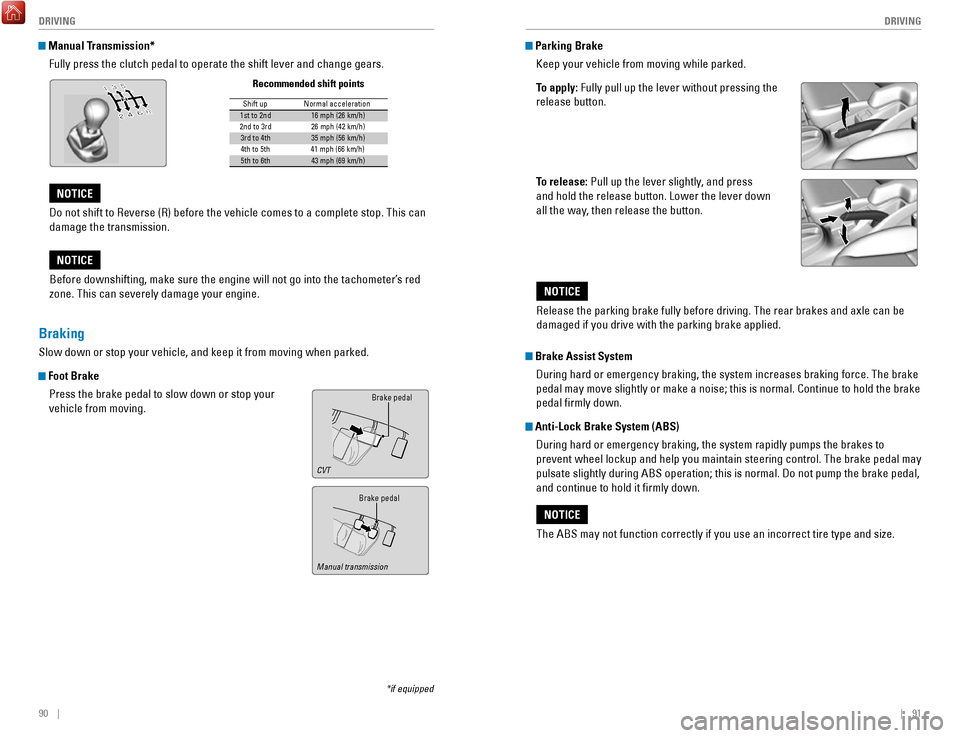
90 || 91
DRIVING
DRIVING
Manual Transmission*
Fully press the clutch pedal to operate the shift lever and change gears\
.
Do not shift to Reverse (R) before the vehicle comes to a complete sto\
p. This can
damage the transmission.
NOTICE
Before downshifting, make sure the engine will not go into the tachomete\
r’s red
zone. This can severely damage your engine.
NOTICE
Shift up Normal acceleratio n1st to 2n d16 mph (26 km/h)
2nd to 3rd 26 mph (42 km/h)
3rd to 4th35 mph (56 km/h)
4th to 5th 41 mph (66 km/h)
5th to 6th43 mph (69 km/h)
Recommended shift points
*if equipped
Braking
Slow down or stop your vehicle, and keep it from moving when parked.
Foot Brake
Press the brake pedal to slow down or stop your
vehicle from moving.
Brake pedal
Brake pedal
CVT
Manual transmission
Parking Brake
Keep your vehicle from moving while parked.
To apply: Fully pull up the lever without pressing the
release button.
To release: Pull up the lever slightly, and press
and hold the release button. Lower the lever down
all the way, then release the button.
The ABS may not function correctly if you use an incorrect tire type and\
size.
NOTICE
Brake Assist System During hard or emergency braking, the system increases braking force. The brake
pedal may move slightly or make a noise; this is normal. Continue to hol\
d the brake
pedal firmly down.
Anti-Lock Brake System (ABS) During hard or emergency braking, the system rapidly pumps the brakes to
prevent wheel lockup and help you maintain steering control. The brake p\
edal may
pulsate slightly during ABS operation; this is normal. Do not pump the b\
rake pedal,
and continue to hold it firmly down.
Release the parking brake fully before driving. The rear brakes and axle\
can be
damaged if you drive with the parking brake applied.
NOTICE
Page 53 of 76
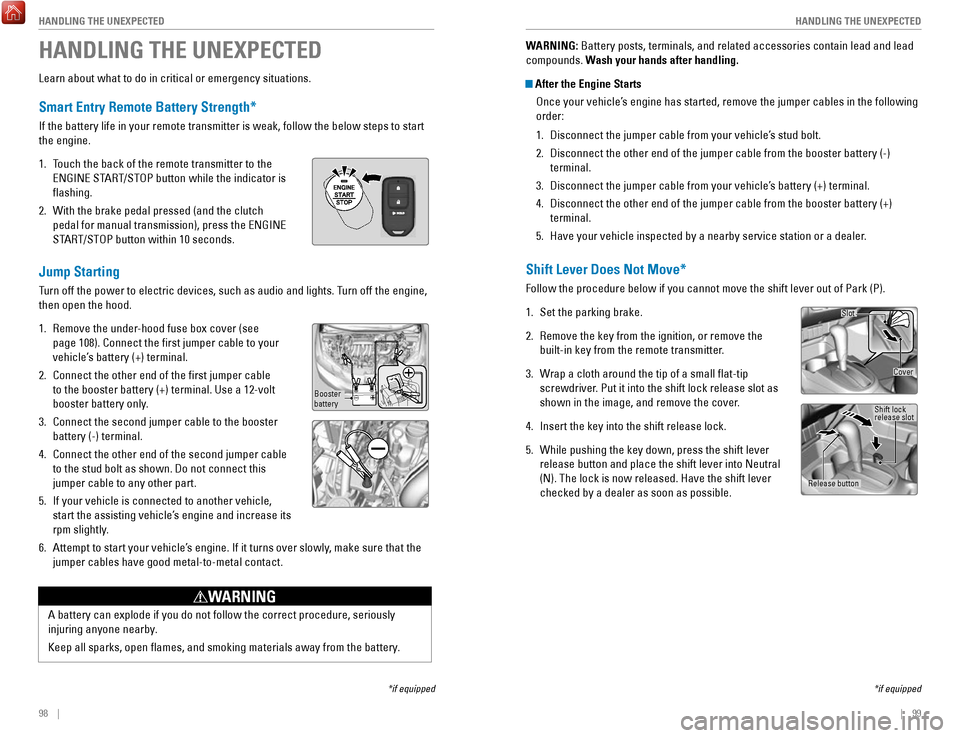
98 || 99
HANDLING THE UNEXPECTED
HANDLING THE UNEXPECTED
Learn about what to do in critical or emergency situations.
Smart Entry Remote Battery Strength*
If the battery life in your remote transmitter is weak, follow the below\
steps to start
the engine.
1.
Touch the back of the remote transmitter to the
ENGINE START/STOP button while the indicator is
flashing.
2.
With the brake pedal pressed (and the clutch
pedal for manual transmission), press the ENGINE
START/STOP button within 10 seconds.
Jump Starting
Turn off the power to electric devices, such as audio and lights. Turn off the engine,
then open the hood.
1.
Remove the under-hood fuse box cover (see
page 108). Connect the first jumper cable to your
vehicle’s battery (+) terminal.
2.
Connect the other end of the first jumper cable
to the booster battery (+) terminal. Use a 12-volt
booster battery only.
3.
Connect the second jumper cable to the booster
battery (-) terminal.
4.
Connect the other end of the second jumper cable
to the stud bolt as shown. Do not connect this
jumper cable to any other part.
5.
If your vehicle is connected to another vehicle,
start the assisting vehicle’s engine and increase its
rpm slightly.
6.
Attempt to start your vehicle’s engine. If it turns over slowly, make sure that the
jumper cables have good metal-to-metal contact.
HANDLING THE UNEXPECTED
*if equipped
A battery can explode if you do not follow the correct procedure, seriou\
sly
injuring anyone nearby.
Keep all sparks, open flames, and smoking materials away from the batt\
ery.
WARNING
Booster
battery
WARNING: Battery posts, terminals, and related accessories contain lead and lead\
compounds. Wash your hands after handling.
After the Engine Starts Once your vehicle’s engine has started, remove the jumper cables in the following
order:
1.
Disconnect the jumper cable from your vehicle’s stud bolt.
2.
Disconnect the other end of the jumper cable from the booster battery (\
-)
terminal.
3.
Disconnect the jumper cable from your vehicle’s battery (+) terminal.
4.
Disconnect the other end of the jumper cable from the booster battery (\
+)
terminal.
5.
Have your vehicle inspected by a nearby service station or a dealer.
Shift Lever Does Not Move*
Follow the procedure below if you cannot move the shift lever out of Par\
k (P).
1.
Set the parking brake.
2.
Remove the key from the ignition, or remove the
built-in key from the remote transmitter.
3.
Wrap a cloth around the tip of a small flat-tip
screwdriver. Put it into the shift lock release slot as
shown in the image, and remove the cover
.
4.
Insert the key into the shift release lock.
5.
While pushing the key down, press the shift lever
release button and place the shift lever into Neutral
(N). The lock is now released. Have the shift lever
checked by a dealer as soon as possible.
*if equipped
Slot
Release button Shift lock
release slot
Cover
Page 54 of 76

100 || 101
HANDLING THE UNEXPECTED
HANDLING THE UNEXPECTED
Overheating
If the high temperature indicator comes on, the engine suddenly loses po\
wer, or
steam or spray comes out from under the hood, your engine is overheating\
.
1.
Immediately park the vehicle in a safe place. Turn
off all accessories and turn on the hazard warning
lights.
2.
If steam or spray is not present: Keep the engine
running and open the hood.
If steam or spray is present: Turn off the engine and
wait until it subsides. Then, open the hood.
3.
Check that the cooling fan is operating and stop the engine once the hig\
h
temperature indicator goes off. If the cooling fan is not operating, imm\
ediately
stop the engine.
4.
Once the engine has cooled down, inspect the coolant level and check the\
cooling system components for leaks. If the coolant level in the reserve\
tank
is low, add coolant until it reaches the MAX mark. If there is no coolant in t\
he
reserve tank, make sure the radiator is cool, then cover the radiator ca\
p
with a
heavy cloth and open the cap. If necessary, add coolant up to the base of the
filler neck, and put the cap back on.
Once the engine has cooled sufficiently, restart it and check the high temperature
indicator. If the indicator is off, resume driving. If it stays on, contact a dealer for
repairs.
Steam and spray from an overheated engine can seriously scald you.
Do not open the hood if steam is coming out.
WARNING
Removing the radiator cap while the engine is hot can cause the coolant \
to
spray out, seriously scalding you.
Always let the engine and radiator cool down before removing the radiato\
r cap.
WARNING
Continuing to drive with the temperature gauge needle at the H mark may \
damage
the engine.
NOTICE
Reserve tank MAX
MIN
Emergency Engine Stop*
The ENGINE START/STOP button may be used to stop the engine due to an
emergency situation even while driving. Do not press the button while driving unless
it is absolutely necessary for the engine to be switched off. If you mus\
t stop the
engine, choose one of the following operations:
•
Press and hold the ENGINE START/STOP button for
two seconds, or
•
Firmly press the ENGINE START/STOP button two
times.
The steering wheel will remain unlocked. However, turning off the engine disables
the power assist to the steering and braking systems, so the vehicle wil\
l
require
significantly more effort and time to steer and slow. Downshift gears and use both
feet on the brake pedal, if necessary, to slow the vehicle and stop immediately in a
safe place.
For CVT models, the power mode changes to ACCESSORY. Manual transmission
models change to OFF.
Canadian CVT models
Then press the ENGINE START/STOP button two times without pressing the brake
pedal.
Emergency Towing
Call a professional towing service if you need to tow your vehicle.
Flat bed equipment: The operator loads your vehicle on the back of a tru\
ck. This is
the best way to transport your vehicle.
Wheel lift equipment: The tow truck uses two pivoting arms that go under\
the front
tires and lift them off the ground. The rear tires remain on the ground.\
This is an
acceptable way to tow your vehicle.
Trying to lift or tow your vehicle by the bumpers will cause serious dama\
ge. The
bumpers are not designed to support the vehicle’s weight.
Improper towing such as towing behind a motorhome or other motor vehicle\
can
damage the transmission.
NOTICE
*if equipped
Page 56 of 76
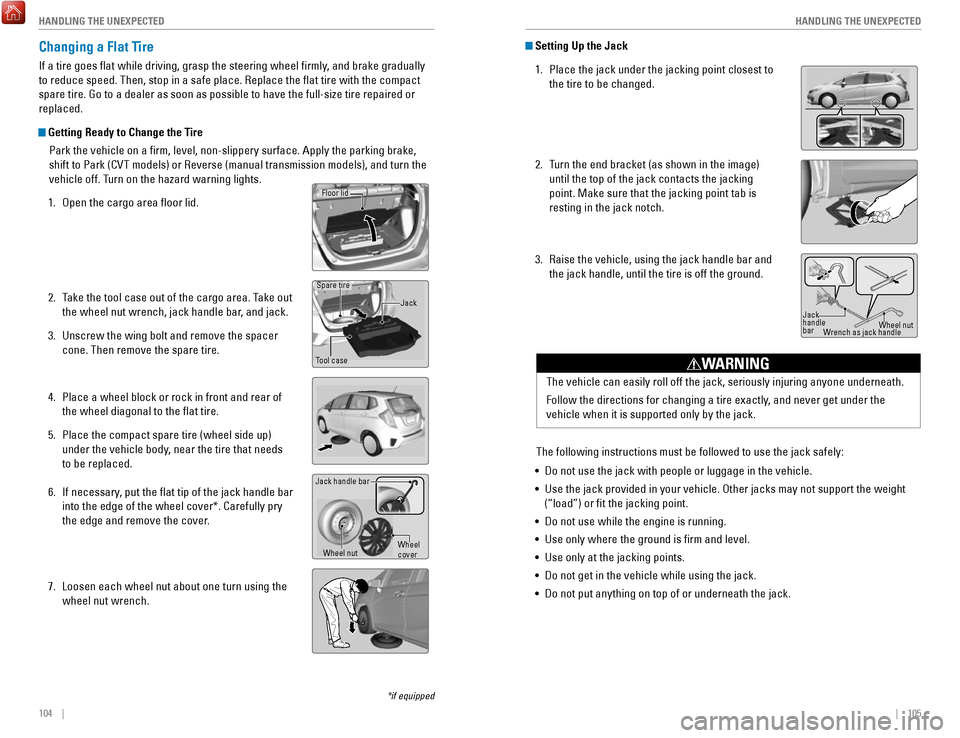
104 || 105
HANDLING THE UNEXPECTED
HANDLING THE UNEXPECTED
Changing a Flat Tire
If a tire goes flat while driving, grasp the steering wheel firmly, and brake gradually
to reduce speed. Then, stop in a safe place. Replace the flat tire wit\
h the compact
spare tire. Go to a dealer as soon as possible to have the full-size tir\
e repaired or
replaced.
Getting Ready to Change the Tire
Park the vehicle on a firm, level, non-slippery surface. Apply the par\
king brake,
shift to Park (CVT models) or Reverse (manual transmission models), \
and turn the
vehicle off. Turn on the hazard warning lights.
1.
Open the cargo area floor lid.
2.
Take the tool case out of the cargo area. Take out
the wheel nut wrench, jack handle bar
, and jack.
3.
Unscrew the wing bolt and remove the spacer
cone. Then remove the spare tire.
4.
Place a wheel block or rock in front and rear of
the wheel diagonal to the flat tire.
5.
Place the compact spare tire (wheel side up)
under the vehicle body, near the tire that needs
to be replaced.
6.
If necessary, put the flat tip of the jack handle bar
into the edge of the wheel cover*. Carefully pry
the edge and remove the cover.
7.
Loosen each wheel nut about one turn using the
wheel nut wrench.
Tool case Spare tire
Jack
Wheel nut
Jack handle bar
Wheel
cover
Floor lid
Setting Up the Jack1.
Place the jack under the jacking point closest to
the tire to be changed.
2.
Turn the end bracket (as shown in the image)
until the top of the jack contacts the jacking
point. Make sure that the jacking point tab is
resting in the jack notch.
3.
Raise the vehicle, using the jack handle bar and
the jack handle, until the tire is off the ground.
The following instructions must be followed to use the jack safely:
•
Do not use the jack with people or luggage in the vehicle.
•
Use the jack provided in your vehicle. Other jacks may not support the w\
eight
(“load”) or fit the jacking point.
•
Do not use while the engine is running.
•
Use only where the ground is firm and level.
•
Use only at the jacking points.
•
Do not get in the vehicle while using the jack.
•
Do not put anything on top of or underneath the jack. The vehicle can easily roll off the jack, seriously injuring anyone unde\
rneath.
Follow the directions for changing a tire exactly, and never get under the
vehicle when it is supported only by the jack.
WARNING
Jack
handle
bar
Wheel nut
Wrench as jack handle
*if equipped
Page 68 of 76

128 || 129
MAINTENANCE
MAINTENANCE
Temperature
The temperature grades are A (the highest), B, and C, representing the\
tire’s
resistance to the generation of heat and its ability to dissipate heat w\
hen tested
under controlled conditions on a specified indoor laboratory test whee\
l. Sustained
high temperature can cause the material of the tire to degenerate and re\
duce
tire life, and excessive temperature can lead to sudden tire failure. Th\
e grade
C corresponds to a level of performance which all passenger car tires must
meet under the Federal Motor Vehicle Safety Standard No. 109. Grades B and
A represent higher levels of performance on the laboratory test wheel th\
an the
minimum required by law.
WARNING: The temperature grade for this tire is established for a tire that
is properly inflated and not overloaded. Excessive speed, underinfla\
tion, or
excessive loading, either separately or in combination, can cause heat b\
uildup
and possible tire failure.Testing of Readiness Codes
Your vehicle has readiness codes as part of the onboard self-diagnostic s\
ystem.
Some states use these codes to verify whether your vehicle’s emissions components
are working properly. The codes may not be read if you go through the emissions
testing just after the battery has gone dead or been disconnected.
To check if they are set, turn the vehicle on without starting the engine\
. The
malfunction indicator lamp will come on for several seconds. If it goes \
off, the
readiness codes are set. If it blinks five times, the readiness codes \
are not set.
If you are required to have your vehicle emissions tested before the rea\
diness codes
are set, prepare the vehicle for retesting by doing the following:
1.
Fill the gas tank to approximately 3/4 full.
2.
Park the vehicle and leave the engine off for 6 hours or more.
3.
Make sure the ambient temperature is between 40°F and 95°F (4°\
C and 35°C).
4.
Start the engine without touching the accelerator pedal, and let it idle\
for 20
seconds.
5.
Keep the vehicle in Park (P) or Neutral (manual transmission). Incre\
ase the engine speed to 2,000 rpm, and hold it there for about 3 minutes.
6.
Let the engine idle with your foot off the accelerator for 20 seconds.
7.
Select a nearby, lightly traveled major highway where you can maintain a speed
of 50 to 60 mph (80 to 97 km/h) for at least 20 minutes. Drive on the \
highway with
the vehicle in Drive (D) or 6th gear (manual transmission). Do not u\
se cruis
e
control. When traffic allows, drive for 90 seconds without using the a\
ccelerator
pedal. (Vehicle speed may vary slightly; this is OK.) If you cannot do this for
a continuous 90 seconds because of traffic conditions, drive for at le\
ast 30
seconds, then repeat two more times (for a total of 90 seconds).
8.
Drive in city or suburban traffic for at least 10 minutes. When traffi\
c conditions
allow, let the vehicle coast for several seconds without using the acceler
ator
pedal or the brake pedal.
9.
Park the vehicle and leave the engine off for 30 minutes.
The readiness codes are erased when the battery is disconnected, and set\
again
only after several days of driving under a variety of conditions.
If an emissions testing facility determines that the readiness codes are\
not set, you
may be requested to return at a later date to complete the test, or see \
your dealer.
Page 69 of 76
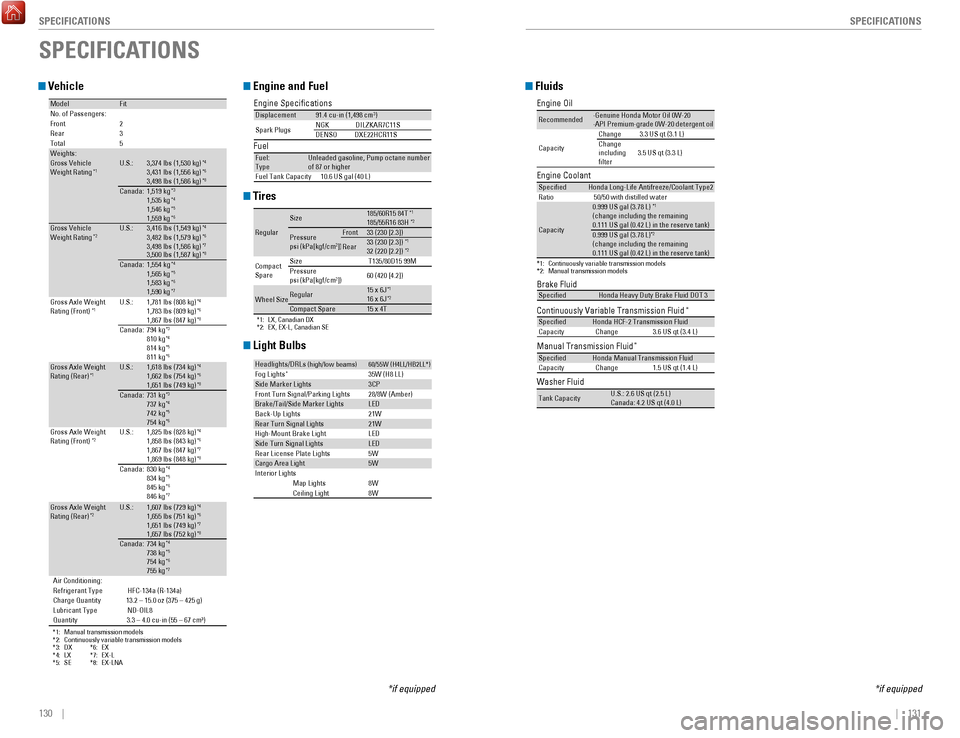
130 || 131
SPECIFICATIONS
SPECIFICATIONS
Vehicle
Air Conditioning:
Refrigerant Type HFC-134a (R-134a )
Charge Quantity 13.2 – 15.0 oz (375 – 425 g)
Lubricant Type ND-OIL8
Quantity 3.3 – 4.0 cu-in (55 – 67 cm³)
ModelFitNo. of Passengers:
Front2
Rear 3
5
Tota lWeights :
Gross Vehicle
Weight Rating*1U.S. :3 ,374 lbs (1,530 kg )*43,431 lbs (1,556 kg )*63,498 lbs (1,586 kg)*8Canada:1,519 kg*31,535 k g*41,546 kg*51,559 kg*6Gross Vehicle Weight Rating*2U.S.:3 ,416 lbs (1,549 kg )*43,482 lbs (1,579 kg )*63,498 lbs (1,586 kg)*7
Canada:1,554 kg*41,565 k g*51,583 kg*61,590 kg*7Gross Axle Weight Rating (Front)*1
Canada:794 k g*3
U.S. :1 ,781 lbs (808 kg )*41,783 lbs (809 kg )*61,867 lbs (847 kg)*8
810 kg*4814 kg*5811 kg*6Gross Axle Weight Rating (Rear)*1
Canada:731 k g*3
U.S. :1 ,618 lbs (734 kg )*41,662 lbs (754 kg )*61,651 lbs (749 kg)*8
737 kg*4742 kg*5754 kg*6
*
*1:
Manual transmission models
* 2:
Continuously variable transmission models
* 3:
DX
* 4:
LX *
5: SE *6:
EX
* 7:
EX-L
8: EX-LNA
Rating (Front)*2U.S.:
Gross Axle Weight 1,825 lbs (828 kg)*41,858 lbs (843 kg)*61,867 lbs (847 kg)*7
Canada:830 kg*4834 kg*5845 kg*6846 kg*7
Gross Axle Weight
Rating (Rear )*2U.S.:1,607 lbs (729 kg)*41,655 lbs (751 kg)*61,651 lbs (749 kg)*7
Canada:734 kg*4738 kg*5754 kg*6755 kg*7
3,500 lbs (1,587 kg )*8
1,869 lbs (848 kg)*8
1,657 lbs (752 kg)*8
Engine and Fuel
Engine Speci�cations
FuelDisplacement91.4 cu-in (1,498 cm3)
Spark Plug sNGKD
ILZKAR7C11S
DENSODXE22HCR11S
Fuel:
Typ eUnleaded gasoline, Pump octane number of 87 or higher
Fuel Tank Capacity 10.6 US gal (40 L)
Tires
*1: LX, Canadian DX*2: EX, EX-L, Canadian SE
Regular
Size185/60R15 84 T*1185/55R16 83H*2
Pressure
psi (kPa[kgf/cm2])
Front33 (230 [2.3])
Rear33 (230 [2.3])*132 (220 [2.2])*2
Compact
Spar e Size
T135/80D15 99M
Pressure
psi (kPa[kgf/cm2]) 60 (420 [4.2])
Wheel SizeRegular15 x 6J*116 x 6J*2Co
mpact Spar e15 x 4T
SPECIFICATIONS
*if equipped
Light Bulbs
60/55W (H4LL/HB2LL*)Fog Lights*35W (H8 LL)Side Marker Lights3CP
Front Turn Signal/Parking Lights
Brake/Tail/Side Marker LightsLE D
Back-Up Lights
Rear Turn Signal Lights21W
High-M ount Brake Light
Side Turn Signal LightsLED
Rear License Plate Light s
Cargo Area Light5W
In teri or Lights
Map Lights8WCeiling Ligh t
Headlights/DRLs (high/low beams )
28/8W (Amber)
21W
LED
5W
8W
Fluids
Brake Fluid
Continuously Variable Transmission Fluid *
Manual Transmission Fluid*
Speci�edHonda Heavy Duty Brake Fluid DOT 3
Speci�edHonda HCF-2 Transmission Fluid
Capacity Change 3.6 US qt (3.4 L)
Speci�edHonda Manual Transmission Fluid
Capacity Change 1.5 US qt (1.4 L)
Engine Oil
Engine Coolan
t
*1:Continuously variable transmission models*2:Manual transmission model s
Recommended·Genuine Honda Motor Oil 0W-2 0
·API Premium-grade 0W-20 detergent oi l
Capacity Change
3.3 US qt (3.1 L)
Change
including
�lter 3.5 US qt (3.3 L)
Speci�e
dHonda Long-Life Anti freeze/Coolant Type 2
Ratio 50/50 with distilled wate r
Capacity
0.999 US gal (3.78 L) *1(change including the remaining
0.111 US gal (0.42 L) in the reserve tank )
0.999 US gal (3.78 L)*2
(change including the remaining
0.111 US gal (0.42 L) in the reserve tank )
Washer Fluid
Tank CapacityU.S.: 2.6 US qt (2.5 L)
Canada: 4.2 US qt (4.0 L)
*if equipped
Page 75 of 76
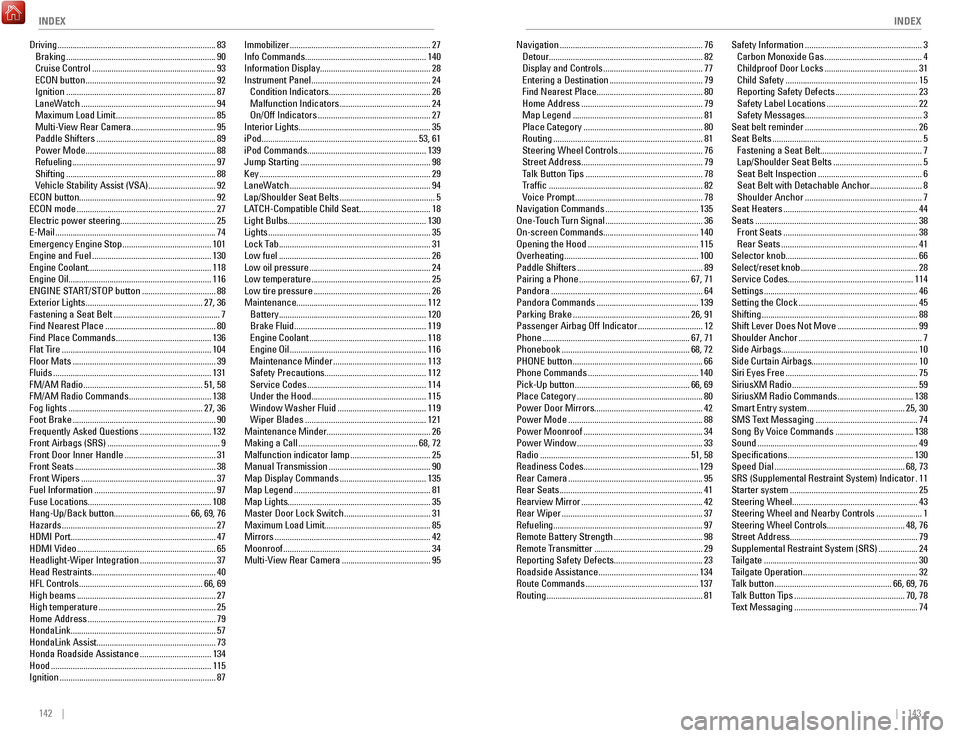
142 || 143
INDEX
INDEX
Driving ........................................................................\
. 83
Braking ..................................................................... 90
Cruise Control ......................................................... 93
ECON button ............................................................ 92
Ignition ..................................................................... 87
LaneWatch .............................................................. 94
Maximum Load Limit .............................................. 85
Multi-View Rear Camera ....................................... 95
Paddle Shifters ....................................................... 89
Power Mode ............................................................ 88
Refueling .................................................................. 97
Shifting ..................................................................... 88
Vehicle Stability Assist (VSA) ............................... 92
ECON button...............................................................
92
ECON mode
................................................................ 27
Electric power steering............................................
25
E-Mail
........................................................................\
.. 74
Emergency Engine Stop ......................................... 101
Engine and Fuel ....................................................... 130
Engine Coolant.........................................................
118
Engine Oil.................................................................. 116 ENGINE START/STOP button
.................................. 88
Exterior Lights ...................................................... 27,
36
Fastening a Seat Belt
................................................. 7
Find Nearest Place ................................................... 80
Find Place Commands ............................................ 136
Flat Tire ..................................................................... 104
Floor Mats .................................................................. 39
Fluids ........................................................................\
. 131
FM/AM Radio ....................................................... 51,
58
FM/AM Radio Commands
...................................... 138
Fog lights .............................................................. 27,
36
Foot Brake
.................................................................. 90
Frequently Asked Questions ................................. 132
Front Airbags (SRS) .................................................... 9
Front Door Inner Handle .......................................... 31
Front Seats ................................................................. 38
Front Wipers .............................................................. 37
Fuel Information ........................................................ 97
Fuse Locations.........................................................
108
Hang-Up/Back button................................... 66, 69, 76
Hazards
....................................................................... 27
HDMI Port...................................................................
47
HDMI Video
................................................................ 65
Headlight-Wiper Integration ................................... 37
Head Restraints ......................................................... 40
HFL Controls ......................................................... 66,
69
High beams
................................................................ 27
High temperature ...................................................... 25
Home Address ........................................................... 79
HondaLink...................................................................
57
HondaLink Assist....................................................... 73 Honda Roadside Assistance
................................. 134
Hood ........................................................................\
.. 115
Ignition ........................................................................\
87Immobilizer
.................................................................
27
Info Commands........................................................ 140
Information Display................................................... 28
Instrument Panel
....................................................... 24
Condition Indicators ............................................... 26
Malfunction Indicators .......................................... 24
On/Off Indicators .................................................... 27
Interior Lights.............................................................
35
iPod........................................................................\
53, 61 iPod Commands....................................................... 139Jump Starting
............................................................ 98
Key ........................................................................\
....... 29
LaneWatch ................................................................. 94
Lap/Shoulder Seat Belts ............................................ 5
LATCH-Compatible Child Seat ................................. 18
Light Bulbs................................................................
130
Lights
........................................................................\
... 35
Lock Tab ...................................................................... 31
Low fuel ...................................................................... 26
Low oil pressure ........................................................ 24
Low temperature ....................................................... 25
Low tire pressure ...................................................... 26
Maintenance............................................................
112
Battery
.................................................................... 120
Brake Fluid ............................................................. 119
Engine Coolant ...................................................... 118
Engine Oil ............................................................... 116
Maintenance Minder ........................................... 113
Safety Precautions ............................................... 112
Service Codes ....................................................... 114
Under the Hood ..................................................... 115
Window Washer Fluid ......................................... 119
Wiper Blades ........................................................ 121
Maintenance Minder................................................
26
Making a Call
....................................................... 68,
72
Malfunction indicator lamp
..................................... 25
Manual Transmission ............................................... 90
Map Display Commands ........................................ 135
Map Legend ............................................................... 81
Map Lights..................................................................
35
Master Door Lock Switch
........................................ 31
Maximum Load Limit................................................. 85
Mirrors
........................................................................\
42
Moonroof .................................................................... 34
Multi-View Rear Camera ......................................... 95Navigation
..................................................................
76
Detour ....................................................................... 82
Display and Controls .............................................. 77
Entering a Destination ........................................... 79
Find Nearest Place ................................................. 80
Home Address ........................................................ 79
Map Legend ............................................................ 81
Place Category ....................................................... 80
Routing ..................................................................... 81
Steering Wheel Controls ....................................... 76
Street Address ........................................................ 79
Talk Button T
ips
......................................................78
Traffic ....................................................................... 82
Voice Prompt ........................................................... 78
Navigation Commands ........................................... 135
One-Touch Turn Signal ............................................. 36
On-screen Commands............................................ 140
Opening the Hood
................................................... 115
Overheating..............................................................
100
Paddle Shifters
.......................................................... 89
Pairing a Phone ................................................... 67,
71
Pandora
...................................................................... 64
Pandora Commands ............................................... 139
Parking Brake ...................................................... 26,
91
Passenger Airbag Off Indicator
.............................. 12
Phone .................................................................... 67,
71
Phonebook
........................................................... 68, 72
PHONE button ............................................................ 66
Phone Commands ................................................... 140
Pick-Up button ..................................................... 66,
69
Place Category
.......................................................... 80
Power Door Mirrors..................................................
42
Power Mode
.............................................................. 88
Power Moonroof ....................................................... 34
Power Window .......................................................... 33
Radio ..................................................................... 51,
58
Readiness Codes..................................................... 129 Rear Camera
.............................................................. 95
Rear Seats .................................................................. 41
Rearview Mirror ........................................................ 42
Rear Wiper ................................................................. 37
Refueling.....................................................................
97
Remote Battery Strength
......................................... 98
Remote Transmitter .................................................. 29
Reporting Safety Defects.........................................
23
Roadside Assistance
.............................................. 134
Route Commands .................................................... 137
Routing ........................................................................\
81Safety Information
......................................................
3
Carbon Monoxide Gas ............................................. 4
Childproof Door Locks ........................................... 31
Child Safety ............................................................. 15
Reporting Safety Defects ...................................... 23
Safety Label Locations .......................................... 22
Safety Messages ...................................................... 3
Seat belt reminder .................................................... 26
Seat Belts ..................................................................... 5
Fastening a Seat Belt ............................................... 7
Lap/Shoulder Seat Belts ......................................... 5
Seat Belt Inspection ................................................ 6
Seat Belt with Detachable Anchor........................ 8
Shoulder Anchor
...................................................... 7
Seat Heaters .............................................................. 44
Seats ........................................................................\
... 38
Front Seats .............................................................. 38
Rear Seats ............................................................... 41
Selector knob.............................................................
66
Select/reset knob
...................................................... 28
Service Codes..........................................................
114
Settings
....................................................................... 46
Setting the Clock ....................................................... 45
Shifting ........................................................................\
88
Shift Lever Does Not Move ..................................... 99
Shoulder Anchor ......................................................... 7
Side Airbags............................................................... 10
Side Curtain Airbags................................................. 10
Siri Eyes Free
............................................................. 75
SiriusXM Radio .......................................................... 59
SiriusXM Radio Commands ................................... 138
Smart Entry system ............................................. 25,
30
SMS Text Messaging
............................................... 74
Song By Voice Commands .................................... 138
Sound ........................................................................\
.. 49
Specifications .......................................................... 130
Speed Dial ............................................................ 68,
73
SRS (Supplemental Restraint System) Indicator
. 11
Starter system ........................................................... 25
Steering Wheel..........................................................
43
Steering Wheel and Nearby Controls
..................... 1
Steering Wheel Controls....................................
48, 76
Street Address........................................................... 79 Supplemental Restraint System (SRS)
.................. 24
Tailgate ....................................................................... 30
Tailgate Operation ..................................................... 32
Talk button ...................................................... 66,
69, 76
Talk Button Tips
................................................... 70,
78
Text Messaging
......................................................... 74